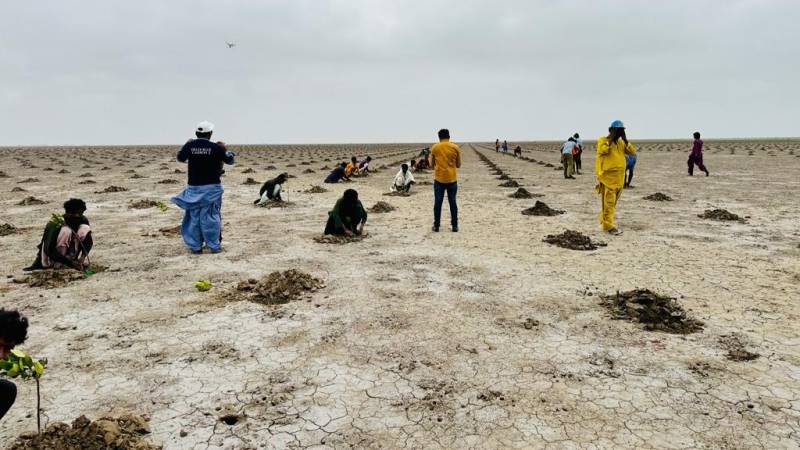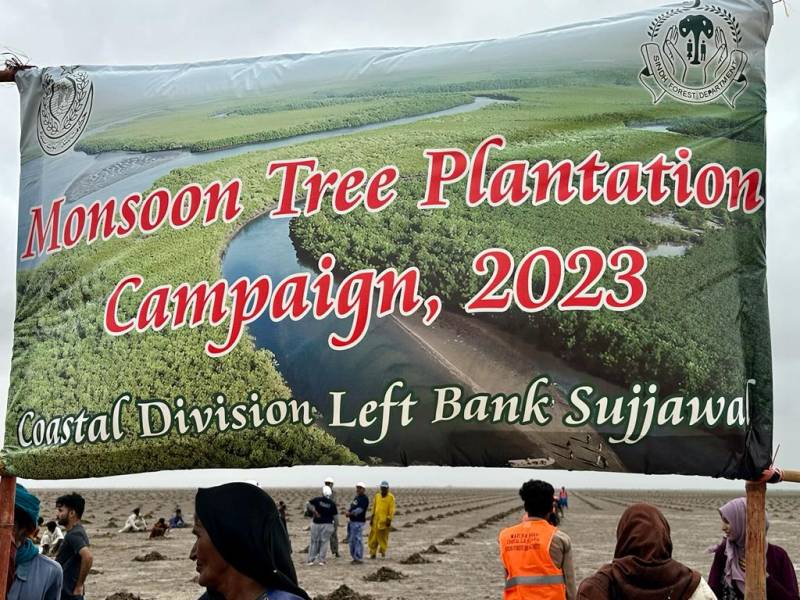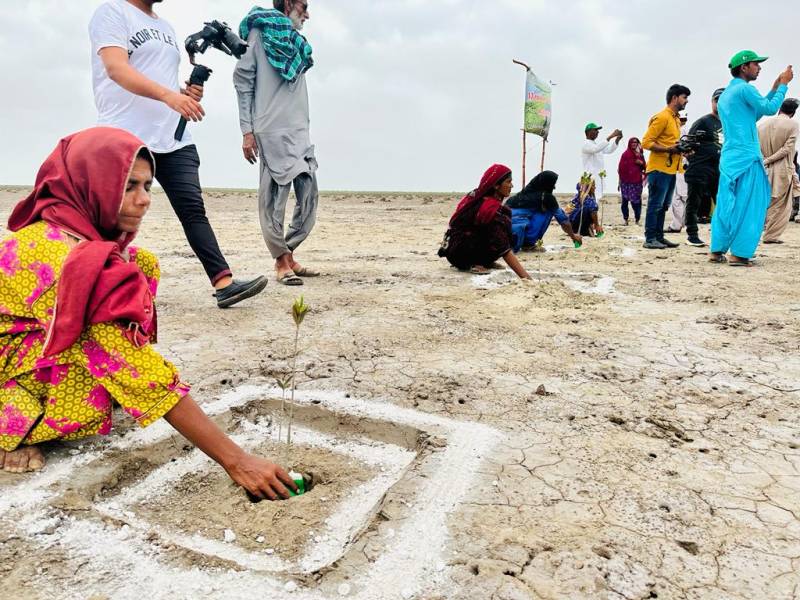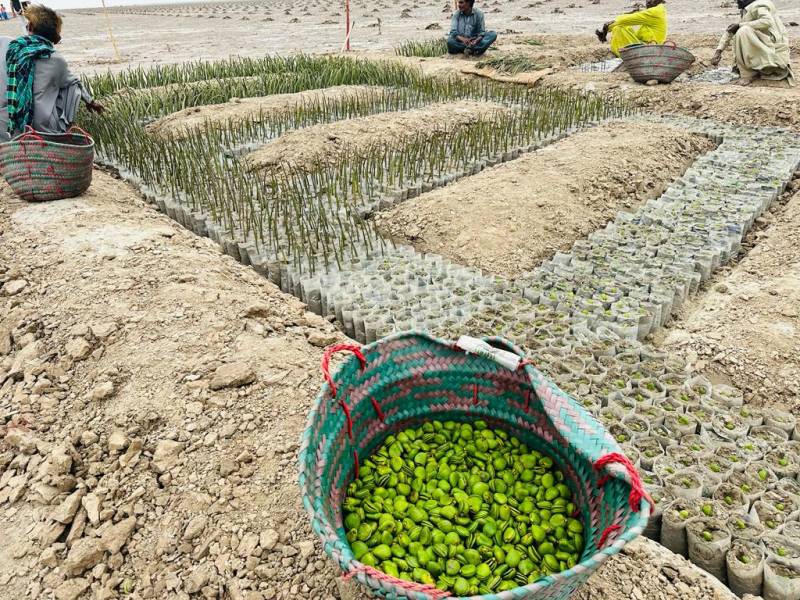
The Sindh government has expanded a project to restore mangrove forests in Sindh in a move that has the potential to generate up to $100 million for the province in foreign direct investment over its lifecycle apart from billions in carbon credit sales.
Officials from the Sindh Forest Department said that the Indus Delta, once the world's fifth largest delta, has substantially reduced in size in recent decades due to a severe water shortage in the Indus River. A document from Pakistan's Ministry of Climate Change and Environmental Coordination stated that a substantial portion of the original mangrove area in the Indus Delta experienced degradation due to freshwater diversion, over-exploitation (including wood, fodder, and grazing), and land-based pollution.
Consequently, this has led to the decline of the estuarine mangrove swamps, locally referred to as 'Timmar'.
This loss of ecology meant that the region was facing climate and other issues, including sea entrenchment and growing aridity.
To reverse this trend, the provincial government in 2015 launched a project called Delta Blue Carbon (DBC) to replenish and restore mangroves in the province. Spread over two projects, it aims to restore mangroves over 450,000 hectares (250,000 hectares in DBC-1 and 200,000 hectares in DBC-2) of the delta in the coastal districts of Thatta and Badin by 2030. By comparison, the Indus Delta is spread over 670,000 hectares.

Riaz Ahmed Wagan, the Chief Conservator at the Sindh Forest Department, said that the Indus Delta has the largest concentration of arid climate mangroves worldwide. The first phase of the DBC project was initiated in 2015. Earlier this year, he said, the department had introduced DBC-2, which will continue their 60-year-long project to restore mangroves with foreign and private funding.
Wagan said that the DBC project had been designed to reduce or remove carbon dioxide from the atmosphere, allowing Pakistan to generate carbon credits. These carbon credits, he said, can be traded in the international carbon market apart from attracting direct investment. The forest department official claimed that the Indus Delta mangrove plantation project is currently Pakistan's only project qualifying for carbon credits trade.
Apart from generating carbon credits, he said that the project will provide valuable support to the local community by aiding fishing activities, mitigating the impacts of climate change, and contributing to the revitalisation of the delta.
Waqar Hussain, a senior official at the Environment, Climate Change and Coastal Development Department in Sindh, emphasized the positive impact of increasing mangrove cover in the Indus Delta on the economy. He pointed out that mangroves can absorb four times more carbon dioxide than other types of trees. Additionally, they serve as protective barriers against cyclones and create vital habitats for aquatic life, which, in turn, benefits the fishing industry.
Generating carbon credits
The two mangrove projects have sequestered a substantial amount of CO2. Wagan said that in 2018, official data puts Pakistan's emissions at 489.87 metric tons of CO2 equivalent (MtCO2e), representing approximately 0.50 percent of global carbon dioxide emissions. This implies that the emissions credits generated by the DBC-1 and DBC-2 projects are roughly equivalent to half of the country's emissions.
Wagan has stated that Pakistan's cumulative carbon offsetting impact through DBC-1 and DBC-2 projects is expected to rise to around 240 million metric tons of carbon dioxide. Specifically, DBC-1 is projected to capture around 140 million MtCO2e through carbon credits, while DBC-2 is anticipated to capture around 100 million MtCO2e through carbon credits.

FDI magnet
Wagan said the two projects are projected to attract foreign direct investment worth around $100 million over its lifecycle.
This includes an estimated investment of $60 million in DBC-1 and an anticipated investment of $40 million in DBC-2.
How carbon credits turn into revenue
The official said that under the Kyoto Protocol and the United Nations Framework Convention on Climate Change (UNFCCC), the Clean Development Mechanism (CDM) allows countries committed to emissions reduction targets to execute projects to curb pollution in developing countries. These projects enable them to earn certified emission reductions (CERs), which help them meet their Kyoto targets.
The Paris Agreement allows private entities to generate and trade carbon credits with international counterparts on voluntary carbon markets.
Credits, earned based on carbon-capturing projects, can be traded on the Voluntary Carbon Market (VCM), a global system for trading carbon offsets, resulting in revenue.
So far, Wagan said, Sindh has successfully sold 3.1 million carbon credits, amounting to a total value of $40 million, selling carbon credits at a rate of $12 - $50, with the price fluctuation reflecting market variations.
By 2075, Sindh is estimated to generate an impressive 140 million carbon credits in the Voluntary Carbon Market (VCM). By then, Wagan estimates, Sindh would generate around $7 billion in certified emission reductions (CERs).

However, with the introduction of DBC-2, he said that the province hopes to add an additional $5 billion by 2075. Thus, the two projects can generate a combined $12 billion by 2075 selling carbon credits produced from the afforestation projects.
Indus Basin and political opposition
While the reforestation efforts seek to address issues of the coastal communities, further up the Indus River lies the Indus Basin Irrigation System. The system is a complex network comprising canals, barrages, and irrigation channels designed to divert water from the Indus River. Its primary purpose is to provide crucial support to agricultural activities, which are vital for Pakistan's economy.
This system features several significant barrages and headworks located along the Indus River. These structures are equipped with gates and sluices to control the water flow and facilitate its redirection into the canal network.
Canals branching off from these barrages serve as conduits for transporting diverted water to various regions for irrigation purposes. To ensure equitable distribution of water to agricultural lands, these canals are further divided into distributaries, minors, and sub-minors.
The management and regulation of water diversion from the Indus River falls under the purview of the Indus River System Authority (IRSA). This governing body oversees the allocation and distribution of water resources among the provinces, ensuring fair and equitable sharing.
It's important to note that water diversion from the Indus River is critical to Pakistan's agricultural practices, contributing significantly to the country's food security and rural livelihoods.
However, it's worth acknowledging that the construction of dams and barrages on the Indus River in Pakistan has sparked controversy and even opposition from quarters in various provinces and nationalist groups that believe such measures eat into their share of water, which dries up into a trickle every successive year.
Sindhi and Pashtun nationalists, in particular, have openly expressed their concerns about the perceived adverse impacts of these projects on their respective regions.
Nationalists in Sindh often oppose the diversion and construction of barrages and dams on the Indus River. They argue that these projects disproportionately benefit areas lying upriver from these artificial interventions, particularly Punjab, at the expense of Sindh. They express concerns about reduced downstream water flow, which can adversely affect agriculture, livelihoods, and the ecological balance in the region. Nationalists also emphasize the cultural and socio-economic impacts, as they believe these projects can lead to the displacement of local communities and the loss of traditional livelihoods.
Dr Qadir Magsi, who leads the nationalist outfit Sindh Taraqi Pasand Party, has voiced concerns about water diversion and theft in the region.
He points out that international agreements recognise the rights of those located at the lower reaches of a river to use water, emphasising that water should not be diverted without their consent.
This perspective underscores the worry that water diversion projects located upstream, particularly those perceived to be affecting the flow of the Indus River, may disproportionately impact downstream provinces like Sindh.
Sindhi nationalists argue that reduced water flow due to diversion can adversely affect their agriculture, livelihoods, and the overall ecosystem of the region. Sea intrusion, they argue, results from reduced water flows in the Indus delta.
Pashtun nationalists are known for their opposition to constructing the Kala Bagh Dam. Their concerns stem from the perception that the dam would primarily benefit Punjab and potentially disrupt water flow downstream, affecting the water availability in Khyber Pakhtunkhwa province. Pashtun nationalists argue that the dam could negatively impact their agriculture, irrigation, and hydroelectric power generation. Consequently, it can endanger Nowshera and its adjoining area.
Shahi Syed, the President of the Sindh chapter of the Awami National Party (ANP), expressed that the ruling class in Pakistan has often disregarded the voices of smaller provinces, leading to disharmony among the people.
He further stated that the Pashtoon community strongly condemns and opposes the construction of the Kala Bagh Dam under any circumstances. Instead, he suggests that if there is a need for building dams in the country, they should be constructed after going through a consensus-building process.
The controversies surrounding the construction of dams and barrages on the Indus River indeed reflect the intricate dynamics and competing interests among various provinces and nationalist groups within Pakistan.
The issue of consent and equitable water sharing among provinces is contentious in Pakistan. The complexities surrounding water rights and allocation have been subject to ongoing debate and negotiation among stakeholders, including provincial governments, nationalist groups, and the federal government.
It's crucial to recognise that perspectives on water diversion projects and consent can vary among different stakeholders, and there may be divergent opinions on the matter both within and outside of Sindh. The management of water resources and the rights of downstream regions continue to be significant points of contention within the country.

